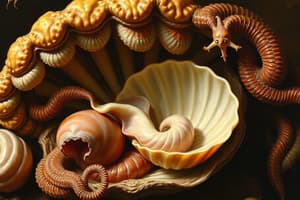Podcast
Questions and Answers
What is the primary function of jaws in gnathostomes?
What is the primary function of jaws in gnathostomes?
- To aid in swimming
- To grasp and tear food (correct)
- To produce sound
- To facilitate breathing
Which characteristic distinguishes Chondrichthyes from other classes of fishes?
Which characteristic distinguishes Chondrichthyes from other classes of fishes?
- Presence of gills
- Presence of bony skeleton
- Presence of cartilaginous skeleton (correct)
- Presence of swim bladder
What is the primary use of vivid coloration in cephalopods?
What is the primary use of vivid coloration in cephalopods?
- Communication with other species
- Camouflage and defense against predators (correct)
- Thermoregulation
- Attracting mates
Approximately how long ago did Chondrichthyes evolve?
Approximately how long ago did Chondrichthyes evolve?
What adaptation allows sharks to detect their prey's electromagnetic fields?
What adaptation allows sharks to detect their prey's electromagnetic fields?
Which anatomical feature is common to all cephalopods?
Which anatomical feature is common to all cephalopods?
How do cephalopods primarily move through water?
How do cephalopods primarily move through water?
Which of the following is NOT commonly found in cartilaginous fishes?
Which of the following is NOT commonly found in cartilaginous fishes?
What characterizes the sex differentiation in cephalopods?
What characterizes the sex differentiation in cephalopods?
How do most sharks typically feed?
How do most sharks typically feed?
What type of feeding strategy is employed by some sharks and rays?
What type of feeding strategy is employed by some sharks and rays?
What is a defining feature of Scaphopoda?
What is a defining feature of Scaphopoda?
Which of these is a characteristic of the Chondrichthyes clade?
Which of these is a characteristic of the Chondrichthyes clade?
What is the significance of water or humidity for annelids?
What is the significance of water or humidity for annelids?
Which characteristic does NOT apply to cephalopods?
Which characteristic does NOT apply to cephalopods?
Which statement about nautilus is true?
Which statement about nautilus is true?
What is the primary function of pharyngeal slits in aquatic organisms?
What is the primary function of pharyngeal slits in aquatic organisms?
In jawed fishes, what do pharyngeal slits become modified into?
In jawed fishes, what do pharyngeal slits become modified into?
What term refers to the group of four-footed animals that includes amphibians, reptiles, birds, and mammals?
What term refers to the group of four-footed animals that includes amphibians, reptiles, birds, and mammals?
Which statement about the post-anal tail is true for most terrestrial vertebrates?
Which statement about the post-anal tail is true for most terrestrial vertebrates?
Where do pharyngeal slits appear in the development of chordates?
Where do pharyngeal slits appear in the development of chordates?
Which of the following is a feature that vertebrates do NOT possess at any stage of their development?
Which of the following is a feature that vertebrates do NOT possess at any stage of their development?
Which group of invertebrates belongs to the phylum Chordata?
Which group of invertebrates belongs to the phylum Chordata?
Why are birds considered tetrapods?
Why are birds considered tetrapods?
Which term refers specifically to species of Testudines that live in freshwater?
Which term refers specifically to species of Testudines that live in freshwater?
Which of the following adaptations in birds allows them to regulate their body temperature?
Which of the following adaptations in birds allows them to regulate their body temperature?
What is the main advantage of birds having pneumatic bones?
What is the main advantage of birds having pneumatic bones?
What distinguishes the respiratory system of birds from that of mammals?
What distinguishes the respiratory system of birds from that of mammals?
What is a primary function of contour feathers in birds?
What is a primary function of contour feathers in birds?
Which anatomical feature do most bird species lack in comparison to other vertebrates?
Which anatomical feature do most bird species lack in comparison to other vertebrates?
What primary benefit do air sacs provide to birds?
What primary benefit do air sacs provide to birds?
What characteristic of birds is primarily responsible for their ability to fly?
What characteristic of birds is primarily responsible for their ability to fly?
What is the primary function of the lateral line in sharks?
What is the primary function of the lateral line in sharks?
Which reproductive strategy is most commonly found in sharks?
Which reproductive strategy is most commonly found in sharks?
How can rays and skates be distinguished from sharks?
How can rays and skates be distinguished from sharks?
What characteristic defines bony fishes (clade Osteichthyes)?
What characteristic defines bony fishes (clade Osteichthyes)?
What is the purpose of the mucus secreted by glands in the skin of bony fishes?
What is the purpose of the mucus secreted by glands in the skin of bony fishes?
What distinguishes oviparous sharks from other reproductive strategies?
What distinguishes oviparous sharks from other reproductive strategies?
What is the primary function of a shark egg case, commonly referred to as a 'mermaid's purse'?
What is the primary function of a shark egg case, commonly referred to as a 'mermaid's purse'?
Which of the following is NOT a characteristic of bony fishes?
Which of the following is NOT a characteristic of bony fishes?
What characteristic is unique to Anura among the clades of Amphibia?
What characteristic is unique to Anura among the clades of Amphibia?
Which type of respiration is not found in adult salamanders?
Which type of respiration is not found in adult salamanders?
How do frogs typically fertilize their eggs?
How do frogs typically fertilize their eggs?
What is the average number of extant amphibian species estimated to exist?
What is the average number of extant amphibian species estimated to exist?
Which of the following best describes the life cycle of frogs?
Which of the following best describes the life cycle of frogs?
Which adaptation helps frogs avoid predation?
Which adaptation helps frogs avoid predation?
What distinguishes Urodela from other amphibian clades?
What distinguishes Urodela from other amphibian clades?
In what environment are frog eggs typically laid?
In what environment are frog eggs typically laid?
Flashcards
Cephalopod Locomotion
Cephalopod Locomotion
Cephalopods move by jet propulsion, contracting their mantle cavity to forcefully expel water.
Cephalopod Camouflage
Cephalopod Camouflage
Cephalopods rapidly change color to match backgrounds or startle predators.
Cephalopod Nervous System
Cephalopod Nervous System
Cephalopods have a well-developed nervous system and complex eyes.
Tusk Shell Structure
Tusk Shell Structure
Signup and view all the flashcards
Cephalopod Shell (Nautilus)
Cephalopod Shell (Nautilus)
Signup and view all the flashcards
Annelida Habitat
Annelida Habitat
Signup and view all the flashcards
Annelida Segmentation
Annelida Segmentation
Signup and view all the flashcards
Cephalopod Tentacles
Cephalopod Tentacles
Signup and view all the flashcards
Pharyngeal slits
Pharyngeal slits
Signup and view all the flashcards
Pharyngeal slits (in fishes)
Pharyngeal slits (in fishes)
Signup and view all the flashcards
Pharyngeal slits (in tetrapods)
Pharyngeal slits (in tetrapods)
Signup and view all the flashcards
Post-anal tail
Post-anal tail
Signup and view all the flashcards
Post-anal tail (function)
Post-anal tail (function)
Signup and view all the flashcards
Invertebrate chordates
Invertebrate chordates
Signup and view all the flashcards
Urochordata (tunicates)
Urochordata (tunicates)
Signup and view all the flashcards
Cephalochordata (lancelets)
Cephalochordata (lancelets)
Signup and view all the flashcards
Gnathostomes
Gnathostomes
Signup and view all the flashcards
Jaw Evolution
Jaw Evolution
Signup and view all the flashcards
Chondrichthyes
Chondrichthyes
Signup and view all the flashcards
Shark Skeleton
Shark Skeleton
Signup and view all the flashcards
Shark Feeding
Shark Feeding
Signup and view all the flashcards
Electroreception
Electroreception
Signup and view all the flashcards
Ampullae of Lorenzini
Ampullae of Lorenzini
Signup and view all the flashcards
Lateral Line
Lateral Line
Signup and view all the flashcards
Shark Reproduction
Shark Reproduction
Signup and view all the flashcards
Shark Egg Case
Shark Egg Case
Signup and view all the flashcards
Rays and Skates
Rays and Skates
Signup and view all the flashcards
Bony Fish Skeleton
Bony Fish Skeleton
Signup and view all the flashcards
Bony Fish Scales
Bony Fish Scales
Signup and view all the flashcards
Bony Fish Lateral Line
Bony Fish Lateral Line
Signup and view all the flashcards
Osteichthyes
Osteichthyes
Signup and view all the flashcards
Amphibian Diversity
Amphibian Diversity
Signup and view all the flashcards
Salamander Features
Salamander Features
Signup and view all the flashcards
Frog Adaptations
Frog Adaptations
Signup and view all the flashcards
Frog Parental Care
Frog Parental Care
Signup and view all the flashcards
Tadpole Stage
Tadpole Stage
Signup and view all the flashcards
Frog Metamorphosis
Frog Metamorphosis
Signup and view all the flashcards
Amphibian Reproduction
Amphibian Reproduction
Signup and view all the flashcards
Amphibian Habitat
Amphibian Habitat
Signup and view all the flashcards
What is a bird?
What is a bird?
Signup and view all the flashcards
Feathers
Feathers
Signup and view all the flashcards
Pneumatic bones
Pneumatic bones
Signup and view all the flashcards
Bird respiration
Bird respiration
Signup and view all the flashcards
Endothermy
Endothermy
Signup and view all the flashcards
Adaptation for flight
Adaptation for flight
Signup and view all the flashcards
Bird evolution
Bird evolution
Signup and view all the flashcards
Why do birds have only one ovary?
Why do birds have only one ovary?
Signup and view all the flashcards
Study Notes
Mollusks and Annelids
- Mollusks are a diverse group of mostly marine species, ranging from predatory squid/octopus to small grazing forms.
- Mollusks have a soft body, ventral muscular foot for locomotion, visceral mass (internal organs), and a dorsal mantle.
- The mantle may or may not secrete a calcium carbonate shell.
- Many mollusks have a radula (scraping structure) at the mouth.
- Mollusks are eucoelomates, but the coelomic cavity is constrained to a region around the heart.
- The mantle cavity houses gills, anus, sensory organs, and gametes.
- Most mollusks have an open circulatory system. Some, like octopuses and squids, have a closed system.
- Mollusks have seven classes: Aplacophora, Monoplacophora, Polyplacophora, Bivalvia, Gastropoda, Cephalopoda, and Scaphopoda.
Annelids
- Annelids (segmented worms) inhabit marine, terrestrial, and freshwater environments.
- Annelids have a segmented body plan (metamerism), allowing for independent modifications in each segment.
- The skin of annelids is protected by a cuticle.
- Chaetae (hair-like extensions) are present in many annelids, defining their group.
- Many polychaetes have parapodia (paired, unjointed limbs) to aid in locomotion and respiration.
- Annelids have a true coelom to hold organs.
- Annelids have a complete digestive system (mouth, pharynx, esophagus, crop etc.).
- They have a closed circulatory system with blood vessels, pumping hearts (anterior), and capillaries.
- Annelids have a "kidney" called metanephridia for excretion.
- Annelids have a nervous system with ventral nerve cords and a nerve ring around the pharynx.
- Annelids are either monoecious or dioecious.
Echinoderms
- Echinoderms have spiny skin composed of ossicles (calcareous skeletal elements).
- Echinoderms exhibit pentaradial symmetry in adults, while larvae stage shows bilateral symmetry.
- Echinoderms have a water vascular system involved in gas exchange, nutrient transport & locomotion.
- Echinoderms have a remarkable ability to regenerate.
- Echinoderms are exclusively marine and include sea stars, brittle stars, sea urchins, sand dollars, and sea cucumbers.
- Echinoderms have a nerve ring and radial nerves extending outward along the arms.
Chordates
- Chordates have a notochord (flexible, rod-shaped structure), dorsal hollow nerve cord, pharyngeal slits, and a post-anal tail.
- Most chordates are vertebrates.
- Vertebrates include the lampreys, fishes, amphibians, reptiles, birds, and mammals.
- Chordates that are not vertebrates include tunicates and lancelets.
- The notochord gives structural support for the developing embryo, while in vertebrates, it's eventually replaced by the vertebral column.
Studying That Suits You
Use AI to generate personalized quizzes and flashcards to suit your learning preferences.




